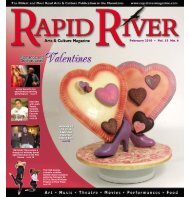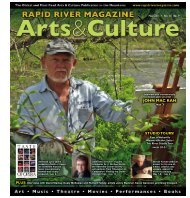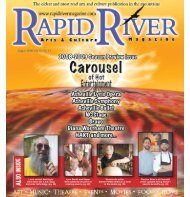FiNE ART - Rapid River Magazine
FiNE ART - Rapid River Magazine
FiNE ART - Rapid River Magazine
You also want an ePaper? Increase the reach of your titles
YUMPU automatically turns print PDFs into web optimized ePapers that Google loves.
R A P I D R I V E R A R T S & C U L T U R E M A G A Z I N E<br />
Who Is It That Is Aware?<br />
Thoughts arise. The human mind<br />
is a thought-producing machine.<br />
Emotions happen. The human<br />
body is a resonance chamber for<br />
the energy of thoughts. A thought<br />
arises in the dimension of mind,<br />
and in the physical dimension of the<br />
body, a resonant emotion is experienced.<br />
A happy thought creates a<br />
happy feeling — expansive, light,<br />
energized. An unhappy thought<br />
creates an unhappy feeling — contracted,<br />
heavy, energy dissipating.<br />
Try it for yourself. Close<br />
your eyes. Think of something or<br />
someone that is very challenging,<br />
Bill<br />
Walz<br />
even threatening to you. Hold that<br />
thought for about five seconds.<br />
Pay attention to the feeling state<br />
that accompanies the holding of<br />
the thought.<br />
Now, think of something or someone<br />
that is supportive, pleasing to you. Hold<br />
that thought for about five seconds. Pay attention<br />
to the feeling state of that thought.<br />
Now, bring all your attention to experiencing<br />
the gentle flow of your breathing.<br />
Do not accentuate or change the breath.<br />
Also listen carefully to the sounds of the<br />
world around you. (turn off any TV or talk<br />
radio – very soft music helps this exercise<br />
— or best of all, go outside and listen to<br />
the birds and the wind in the trees) Do<br />
this for about 15 – 30 seconds. Now, open<br />
your eyes and feel what you feel.<br />
If you are paying very close attention,<br />
you will notice that with the threatening<br />
thought there is a contraction of the<br />
energy of the body and mind into a state of<br />
tension. With the pleasant thought there<br />
is an opening of the energy, the body and<br />
mind relaxes. But with the bringing of<br />
your awareness into the experience of your<br />
breath and listening to the subtle soft<br />
sounds of the world around<br />
you, the feeling state becomes<br />
expansive, open, relaxed, clear,<br />
even happier than the happy<br />
thought. This is the experience<br />
of no-thought. You<br />
are touching the ground of<br />
your deepest level of Being.<br />
<strong>ART</strong>FUL LIVING<br />
by Bill Walz<br />
As you are aware of your thoughts and emotions,<br />
you must ask yourself, who is it that is aware?<br />
- zen koan<br />
Every thought is a contraction<br />
of the energy of the mind from its<br />
original and clear state of awareness<br />
into a limited form. With<br />
the creation of thought, you are<br />
experiencing the creation of egoic separateness<br />
and the loss of oneness with undifferentiated<br />
Life itself. The more fear-based<br />
the thought (a threatening, challenging<br />
thought form), the more the mind and the<br />
resonant body-emotion contracts into its<br />
experience of separateness.<br />
But who is it that is aware of these<br />
various mind-body experiences? Ah!<br />
That’s the secret that we have not been<br />
attending to. We are accustomed to<br />
experiencing that we are the thoughts<br />
and emotions. We say, “I am happy” or “I<br />
am sad” or “I am angry”. But is this true?<br />
Zen teaches us that, no, we are not these<br />
thoughts and emotions. We have these<br />
thoughts and emotions. They are properties<br />
of being human, just<br />
as we have hands and we<br />
have feet. Who we are,<br />
is the awareness that<br />
experiences these<br />
phenomenon of<br />
the mind and body.<br />
As I instructed<br />
you to create a<br />
happy thought,<br />
then an unhappy<br />
thought, how could these<br />
thoughts and emotions be you if you could<br />
voluntarily create them? So then, how can<br />
they be you when they are involuntarily<br />
created? No. Who you are is the awareness<br />
that witnesses the activity of the mind and<br />
the body, but is actually unaffected by this<br />
activity.<br />
Do you see the empowerment and<br />
liberation in this? This is the secret of<br />
meditation. In meditation, as you quiet<br />
the talking and emotionally reactive mind<br />
(in Buddhism, called “little mind”), you<br />
begin to be aware that you are aware. And<br />
as you continue to meditate, you begin<br />
to be aware that you are awareness (“big<br />
mind”). This is the ground of your Being.<br />
Oh, how everything begins to change<br />
then. Thoughts and emotions come and<br />
go. We begin to realize that they are conditioned<br />
patterns of our cultural, societal,<br />
family and personal experience. They are<br />
programmed reactions to situations. They<br />
are certainly not who we are. We can<br />
begin to let them come and go without<br />
investing our sense of self in them.<br />
Defensiveness, reactivity, the need to<br />
identify with them begins to dissolve. We<br />
begin to realize we can shape and refine<br />
them. They are tools, like our hands, that<br />
we can train to be increasingly effective<br />
in dealing with the situations of life. This<br />
is why Buddhism teaches that meditation<br />
is “liberation” leading to an “awakening”<br />
out of living in “small mind” into<br />
the wisdom and effectiveness of a much<br />
larger, more adaptable and compassionate<br />
mind, the mind of awareness itself. And<br />
this is the answer to the question of who<br />
it is that is aware. It is YOU, the deepest,<br />
truest, sanest you.<br />
Bill Walz is a UNCA adjunct faculty member<br />
and a private-practice teacher of mindfulness,<br />
personal growth and consciousness.<br />
He holds a weekly meditation class,<br />
Mondays, 7 p.m. at the Friends Meeting<br />
House, 227 Edgewood. A special extended<br />
meditation and discussion event will be<br />
held at the Meeting House on Saturday,<br />
June 21 entitled “Discover Who You Are at<br />
Your Deepest Level,” from 1-5 p.m.<br />
Info on classes and personal growth and<br />
healing instruction or phone consultations<br />
at (828) 258-3241, or e-mail at healing@<br />
billwalz.com. Visit www.billwalz.com<br />
The newest idea to capture the<br />
imagination of medical investigators<br />
is that inflammation is the<br />
cause of disease. The cause of<br />
heart disease is inflammation of<br />
the lining of the arteries. The<br />
cause of peptic ulcer disease is inflammation<br />
of the lining of the stomach or<br />
small intestine. The cause of cancer of<br />
the colon is inflammation of the lining of<br />
the colon.<br />
Inflammation is the body’s reaction<br />
to irritants with a standard response that<br />
every medical person is taught to recognize<br />
– the simple flair and wheal – the red<br />
reaction and the swelling seen in the skin<br />
after a scratch from a twig or the sting of<br />
a bee. When the irritant comes in contact<br />
with the body, the body reacts with an<br />
inflammatory response.<br />
Chemicals released during this<br />
inflammatory response are anything but<br />
simple. So many chemicals and proteins<br />
are released, the outpouring is called a<br />
The Newest Theory of Disease by Max Hammonds, MD<br />
cascade and there are several cascades<br />
involved. Chemicals and proteins are<br />
released that increase blood clotting,<br />
summon white blood cells (body policemen),<br />
dilate and constrict blood vessels,<br />
increased output of hormones from the<br />
adrenal gland (steroids and epinephrine),<br />
the thyroid gland, the pancreas (insulin<br />
and digestive enzymes), and the pituitary<br />
gland and a host of other proteins that<br />
serve useful purposes during normal<br />
body function but reek havoc during a<br />
prolonged inflammatory response.<br />
The inflammatory response is designed<br />
to answer an emergency call that<br />
invaders (irritants – foreign bodies, foreign<br />
proteins) have entered the body and<br />
must be dealt with. As an acute reaction,<br />
it is very effective. When the irritants continue<br />
to enter the body over a prolonged<br />
period of time, the cascades begin to get<br />
out of control – either getting tired and<br />
dulled and not recognizing invaders who<br />
should be dealt with (bacteria, cancer<br />
cells, or others) or becoming confused<br />
and over-reacting to and attacking normal<br />
body proteins (joint lining as in arthritis,<br />
pancreatic cells as in Type I diabetes, etc.)<br />
There are four major body systems<br />
who are the first to receive outside irritants,<br />
outside invaders. They are the<br />
body systems most exposed to the outside<br />
world.<br />
The outside lining of the body, the<br />
skin, is the most obvious first line of<br />
defense against invasion of irritants. It is<br />
thick and resistant to attack, only reacting<br />
if the tough outer layers of the skin are<br />
broken or have been soaked through (poison<br />
ivy juice or latex, for example). Even<br />
so, some people have sensitive skin that<br />
easily reacts to foreign proteins. We say<br />
these people are allergic. They over react<br />
to invaders that most of us can shrug off.<br />
The inside lining of the body, the<br />
lining of the gut from the mouth to the<br />
anus, is also bombarded constantly by<br />
foreign proteins and foreign particles<br />
that can attach to normal body proteins.<br />
The lining of the gut is not tough; in fact,<br />
it is very thin to facilitate absorption of<br />
digested nutrients. The gut is flushed out<br />
on a regular basis by the large volume of<br />
water it secretes. But a slow or irregular<br />
flush cycle can leave the gut exposed to<br />
these foreign particles causing an inflammatory<br />
response.<br />
The next obvious area exposed to<br />
outside irritants is the breathing system,<br />
the throat and lungs. The lining here is<br />
thin to facilitate the intake of oxygen and<br />
the release of carbon dioxide. It’s protective<br />
mechanism is a lining of small, everwaving<br />
hair-like projections – cilia – that<br />
move irritants up and out of the lung or<br />
down and out of the nose, sometimes<br />
producing a cough or a sneeze to expel<br />
them. Foreign proteins that irritate can<br />
produce spasm of the lungs and in allergic<br />
people is known as asthma.<br />
‘Theory of Disease’ continued on pg. 38<br />
Vol. 11, No. 10 — <strong>Rapid</strong> <strong>River</strong> ArtS & CULTURE <strong>Magazine</strong> — June 2008 31
















